Form 155.16-N3 (899), IsoFlow Absorption Chillers with Buffalo ...
Form 155.16-N3 (899), IsoFlow Absorption Chillers with Buffalo ...
Form 155.16-N3 (899), IsoFlow Absorption Chillers with Buffalo ...
You also want an ePaper? Increase the reach of your titles
YUMPU automatically turns print PDFs into web optimized ePapers that Google loves.
INSULATION<br />
YORK recommends that all absorption equipment be<br />
insulated properly to optimize operating performance,<br />
insure the safety of operating and plant personnel, prevent<br />
sweating, and to prevent crystallization up to eight<br />
hours during a power failure. YORK performance ratings<br />
are based on a properly insulated chiller. Proper<br />
insulation limits the heat loss from the chiller to its surroundings.<br />
Insulation also protects personnel from the<br />
hot surfaces, such as the generator shell and steam/hot<br />
water piping and is often required for safety codes.<br />
Insulating an <strong>IsoFlow</strong> TM absorption chiller requires two<br />
separate types of chiller insulation for both the hot and<br />
cold temperature surfaces. By insulating the hot surfaces,<br />
heat loss to the equipment room is minimized<br />
thereby maximizing efficiency and preventing hazardous<br />
working conditions. Cold insulation is applied to the<br />
chiller to prevent sweating.<br />
For hot surfaces, YORK recommends using a 2 inch<br />
thick 3 lb. density fiberglass insulation. Hot surfaces<br />
that need insulation are the generator, generator heads,<br />
connecting piping, and the solution heat exchanger. Also,<br />
insulate the supply steam or hot water piping to the generator.<br />
For cold surfaces, YORK recommends using 3/4 inch,<br />
closed-cell foam insulation. Cold surfaces that need insulation<br />
are the evaporator heads, refrigerant pump,<br />
evaporator overflow refrigerant box, innerconnecting<br />
piping between and around the refrigerant pump, and<br />
piping to evaporator sprays. As an optional purchase,<br />
these areas can be insulated at the factory.<br />
In some rare cases, when the chiller is operating in high<br />
humid conditions, moisture in the surrounding air may<br />
condense on the evaporator surface. This is normally<br />
not so, because YORK uses a double-wall design in the<br />
evaporator section of the chiller to prevent sweating on<br />
the exterior evaporator surface. If it is preferred to insulate<br />
the evaporator surface, YORK recommends using<br />
the 3/4 inch, closed-cell foam insulation for this purpose.<br />
INSULATION TIPS<br />
Before proceeding <strong>with</strong> the unit insulation, please read<br />
the below for important information about certain precautions<br />
and warnings that must be adhered to.<br />
YORK INTERNATIONAL<br />
FORM <strong>155.16</strong>-<strong>N3</strong><br />
Insulation must not be applied to the<br />
chiller until start-up has been successfully<br />
completed by a qualified York service<br />
technician and chiller is operating<br />
<strong>with</strong> no indication of air leaks.<br />
Glued insulation pins may be used for installing insulation<br />
to the chiller surface, DO NOT USE WELD PINS.<br />
A high temperature adhesive is available and recommended<br />
to adhere the insulation pins to the chiller surface<br />
(See Chemicals and Compounds section of the Renewal<br />
parts form for this epoxy). The surface of the<br />
insulation should be sealed vapor tight to prevent sweating<br />
and mildew underneath the insulation. All seams must<br />
be filled in using insulation tape or thermal mastique<br />
compound. Aluminum facing provides an additional layer<br />
of protection and a quality finish to the job.<br />
Welding anything to the shell or using<br />
weld pins for insulation purposes, may<br />
penetrate the shell and may jeopardize<br />
the integrity of the chiller. Any welding<br />
to the chiller shell <strong>with</strong>out written<br />
consent of York Factory Service will<br />
result in voiding all warranties.<br />
When insulating the chiller, do not cover any sight glasses,<br />
hand valves, or water head bolts and nuts. These areas<br />
must be accessible for service and operating personnel.<br />
If insulation is desired in these areas, do not glue the<br />
insulation to the surface, in that way it can be easily<br />
removed for servicing the unit.<br />
Never insulate the refrigerant or solution<br />
pump motors, these surfaces<br />
must be kept open to the surrounding<br />
air for cooling purposes.<br />
Use Table 4 for purchasing and determining an approximate<br />
amount of hot or cold insulation for the York<br />
<strong>IsoFlow</strong> TM absorption chiller.<br />
INSTALLATION CHECK LIST<br />
At the back of this document is an Installation Check<br />
List which is to be used to insure that all installation<br />
items have been taken care of prior to contacting YORK<br />
for start-up supervision. When satisfied that the installation<br />
is complete, call for the services of a YORK representative<br />
by filling out and submitting the form at the<br />
back of this document. (See page 44.)<br />
41


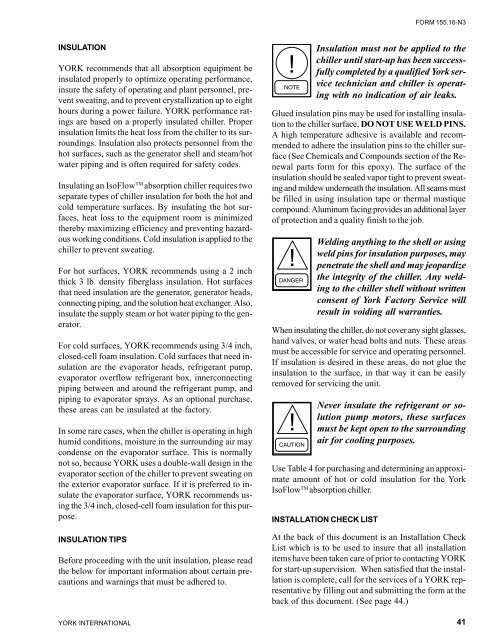
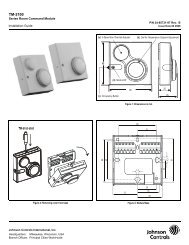
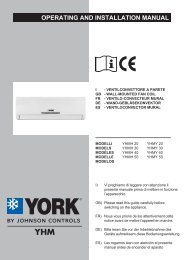



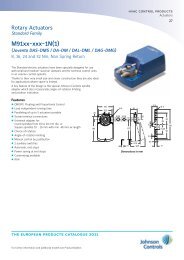


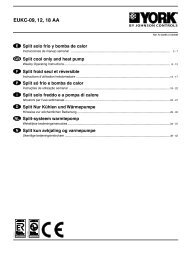
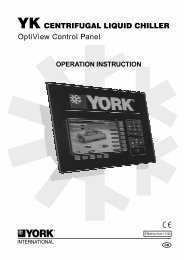
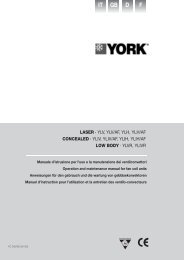
![[PDF] •Outdoor installation 4-5 - Johnson Controls](https://img.yumpu.com/10374038/1/184x260/pdf-ooutdoor-installation-4-5-johnson-controls.jpg?quality=85)
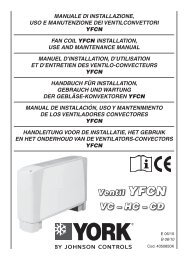
![[PDF] The European Products Catalogue 2012 - Johnson Controls](https://img.yumpu.com/3624903/1/184x260/pdf-the-european-products-catalogue-2012-johnson-controls.jpg?quality=85)